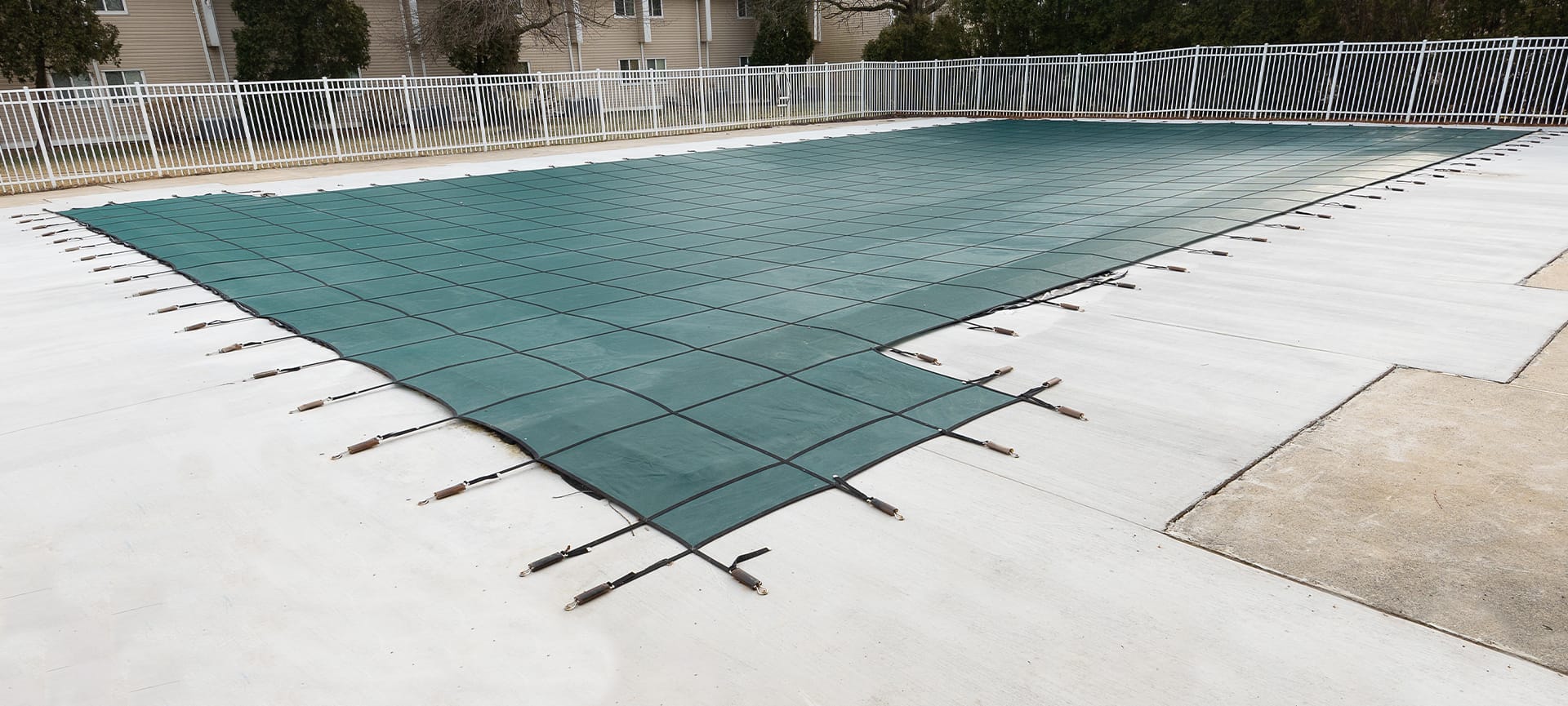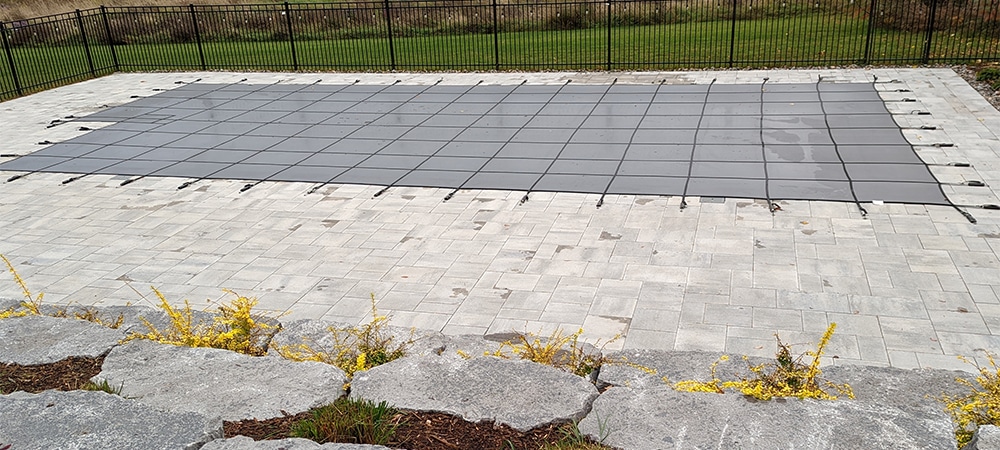How to Winterize a Swimming Pool

Cold temperatures, ice, and snow can cause significant damage if a pool is not properly prepared for the off-season. Failing to winterize a pool correctly can lead to freezing damage, algae growth, and equipment failure.
Winterizing a pool requires careful planning and execution, as every step plays a crucial role in preserving its condition. From balancing water chemistry to securing a pool cover, each task ensures the pool remains clean, protected, and structurally sound throughout the winter months.
Whether you’re closing your pool for the first time or looking for professional maintenance advice, following the right steps will help you avoid costly repairs and extend the life of your pool.
Related Article: What Is the Best Time to Build a Pool?
Step 1: Balance the Pool Water
Before closing a pool for the winter, balancing the water chemistry is a crucial first step. Properly balanced water helps prevent scale buildup, corrosion, and staining, ensuring the pool remains in good condition throughout the off-season.
Key Water Balance Levels to Check:
- pH Level: Should be between 7.2 and 7.6 to prevent water from becoming too acidic or too alkaline.
- Alkalinity: Should be between 80 and 150 ppm (parts per million) to stabilize pH levels.
- Calcium Hardness: Should be between 175 and 225 ppm to prevent corrosion or excessive scale formation.
When water is too acidic, it can cause corrosion of metal components, including ladders, pumps, and heaters. On the other hand, overly alkaline water can lead to calcium deposits and cloudy water, making spring cleanup more difficult.
How to Balance the Water:
- Use a pool water testing kit to measure pH, alkalinity, and calcium hardness.
- Adjust the levels as needed using pH increasers or decreasers, alkalinity balancers, and calcium hardness treatments.
- Shock the pool with chlorine or non-chlorine shock to eliminate bacteria and contaminants.
- Let the water circulate for at least 24 hours before proceeding with winterization steps.
Step 2: Clean the Pool Thoroughly
Once the water chemistry is balanced, deep cleaning the pool is the next essential step. Any debris, dirt, or organic matter left in the water can cause algae growth, staining, and bacteria buildup over the winter months.
Steps to Properly Clean the Pool:
- Remove all debris.
- Brush the walls and floor.
- Vacuum the pool.
- Empty skimmer baskets and pump filters.
- Backwash or clean the pool filter.
Step 3: Lower the Water Level
Reducing the pool’s water level is an essential step in preventing freeze damage during winter. When temperatures drop, water expands as it freezes, which can lead to cracked pipes, damaged skimmers, and structural issues.
How Low Should the Water Level Be?
- Inground Pools: Lower the water level to about 4 to 6 inches below the skimmer to prevent ice from entering and damaging the filtration system.
- Above-Ground Pools: Lower the water to just below the skimmer opening but ensure that hoses and pumps are properly disconnected to prevent ice buildup in the system.

Why You Shouldn’t Drain the Pool Completely
Some homeowners think that completely draining the pool will prevent freezing damage, but this can actually cause structural problems:
- For inground pools: Without water pressure, the liner may shrink or crack, and the entire pool structure could shift due to ground movement.
- For above-ground pools: A lack of water can weaken the pool’s frame and cause the liner to dry out and crack.
By lowering the water level to the recommended height, the pool remains protected while avoiding unnecessary damage to the structure and plumbing.
Step 4: Add Winterizing Chemicals
Once the pool’s water level is properly adjusted, adding winterizing chemicals helps keep the water clean and prevents algae, bacteria, and mineral buildup during the colder months.
Essential Winterizing Chemicals and Their Purpose:
- Chlorine or Non-Chlorine Shock – Kills bacteria and contaminants before closing the pool. A non-chlorine shock treatment is recommended for long-term closures to prevent excess chlorine buildup.
- Algaecide – Prevents algae growth, which thrives in stagnant water. A long-lasting algaecide is ideal for winter protection.
- Stain and Scale Preventer – Reduces mineral deposits and metal stains, keeping the pool walls and surfaces clean.
- Winter Floater (Optional) – Some pool owners use slow-releasing chemical floaters to help maintain chlorine levels over time.
How to Add Winterizing Chemicals:
- Distribute the chemicals evenly across the pool while the pump is running to ensure proper circulation.
- Let the chemicals circulate for at least 24 hours before shutting down the filtration system.
- Avoid over-shocking – Excessive chlorine can damage the pool liner or surfaces. Use only the recommended dosage.
Related Article: How Often Does a Fibreglass Pool Need to Be Resurfaced?
Step 5: Protect the Pool Equipment
Winterizing your pool isn’t just about the water—it’s also about protecting essential equipment from freezing damage. Any water left in pipes, pumps, heaters, or filters can freeze, expand, and cause cracks or malfunctions. Properly draining and storing equipment ensures that your pool system remains in good condition for the next season.
Steps to Winterize Pool Equipment:
- Drain the pump, heater, and filter
- Remove plugs and hoses
- Store accessories and equipment indoors
Related Article: How to Hide Pool Equipment: Landscaping Ideas
Step 6: Cover the Pool Securely
A high-quality pool cover is the final line of defense in winterizing your pool. A properly secured cover prevents debris, sunlight, and moisture from entering the water, reducing the chances of algae growth and contamination.
Choosing the Right Pool Cover:
- Mesh Pool Covers
- Allows rain and snowmelt to drain while keeping out debris.
- Lightweight and easy to handle.
- Best suited for areas with heavy snowfall, as it prevents water from accumulating on top.
- Solid Pool Covers
- Completely blocks out sunlight, preventing algae growth.
- Prevents water evaporation, helping maintain chemical balance.
- Ideal for warmer climates where algae can still develop during winter.
Securing the Pool Cover:
- Ensure the cover fits tightly over the pool, with no gaps where leaves or dirt can enter.
- Use water bags, cover clips, or heavy-duty straps to keep the cover in place, especially in windy areas.
- Periodically remove excess water or snow from the cover to prevent sagging and tearing.

Step 8: Additional Tips for Winter Pool Maintenance
Winterizing your pool doesn’t end once it’s covered—regular maintenance throughout the colder months helps prevent unexpected damage and ensures a smooth reopening in spring.
1. Check the Pool Cover Regularly
- Inspect the cover every few weeks for rips, loose fittings, or excessive weight from snow and ice.
- If snow accumulates, use a soft broom or pool cover pump to remove it—heavy buildup can cause sagging or tearing.
2. Monitor Water Levels
- Even though the pool is closed, evaporation and leaks can still occur.
- If water levels drop too low, it can damage the liner or pool structure.
- If necessary, add water periodically to maintain proper levels.
3. Perform Occasional Chemical Checks
- Test the water every four to six weeks to ensure the pH and alkalinity remain stable.
- If necessary, add a small amount of winterizing chemicals to maintain balance and prevent algae growth.
- Avoid using excessive chemicals, as the pool is not circulating like it would during the summer.
At Green Side Up, we understand that swimming pools need maintenance when they begin to show wear and tear. Learn more about our pool restoration services to keep your pool in appealing state.
Keep Your Pool Protected All Winter Long
Proper winterization is essential for maintaining your pool’s longevity and avoiding expensive repairs in the spring. By following these steps—from balancing the water to securing the cover—homeowners can protect their investment and ensure their pool remains in top condition.
Taking the time to winterize your pool correctly prevents freezing damage, algae growth, and equipment failure, making springtime reopening much smoother.
For expert advice and professional property maintenance services, Green Side Up Contracting is here to help. With their extensive experience in outdoor care and seasonal maintenance, they ensure that your property stays in peak condition year-round. Contact us today for trusted guidance and high-quality service for all your outdoor needs.
